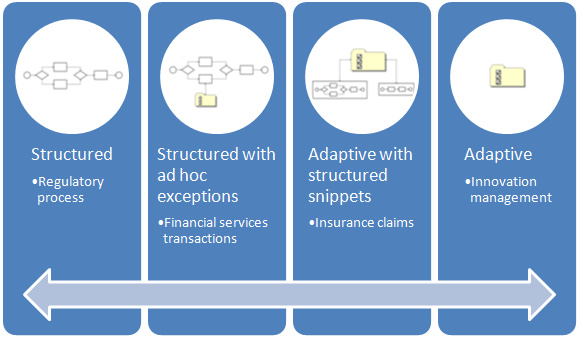It’s the first day of the annual research/academic conference on BPM, this year held in Tallinn, Estonia, and I’m attending the ACM workshop organized by Irina Rychkova of University Paris 1 Pantheon-Sorbonne, Ilia Bider of Stockholm University and IbisSoft, and Keith Swenson of Fujitsu. This is my fifth year at this conference, and I always find it a great opportunity to see what’s going on in the academic research – some of which will eventually make its way into commercial products – as well as meet people from both the research and industry sides.
The workshop days are organized as a series of papers presented on a common theme, kicked off with a keynote from one of the session chairs. In this case, Ilia Bider gave the keynote on a non-workflow theory of business processes. He has a really interesting approach, since he models enterprises as complex multilevel adaptable systems using systems theory (a topic of particular interest, given that my degree is in systems design engineering, which included some amount of systems theory), where process instances (cases) are temporal/situational respondent systems created from system assets as required to address a situation system. This means that an instance is based, in some part, on a process template (the assets from which it is created) as well as sensors that inform it about the situation systems. He describes process instances as moving through state space, and the process model as a set of formal rules describing the valid paths of the possible trajectories. A process model, then, is a state space with a goal defined as a surface within the space, and the set of trajectories defined prescriptively (e.g., using a flow diagram), by constraint-based rules or non-prescriptive methods. Moving from theory to the systems that support adaptive processes/cases, the system must provide a shared map of the multi-dimensional state space so that everyone can see the goal and current position in order to plan the next moves; support for collaboration coordination for complex movements in multiple dimensions simultaneously; and guidance for moving along the trajectories. Unlike structured BPM systems, the latter is not the main focus, although may include concepts of obligation (must), prohibition (can’t), recommendations (should) and discouragements (should not). If the landscape of the state space changes during the execution of an instance, it’s more important to support the visibility of the space and the goals, and allow people to move within the space as required to achieve the goals. Interesting stuff. You can read more of his publications here.
The next paper on ACM from an activity modality perspective, was presented by Lars Taxén of Linköping University in Sweden. He proposes that there are six activity modalities to consider when shifting from a process-centric view to an information-centric view – objectivation, contextualization, spatialization, temporalization, stabilization, and transition – where these represent the innate predispositions that we use for decision-making and taking action. BPMN focuses almost purely on temporalization by modeling the flow; as well as being one-dimensional, it is prescriptive, which doesn’t support adaptive cases/processes very well. Process isn’t unimportant in ACM, but it is there to serve data artifacts in some way; he doesn’t suggest completely discarding process models, but finding more declarative representations than BPMN. Business processes are, of course, multi-dimensional, it has been somewhat of a disservice to focus purely on prescriptive flow models as being the sole embodiment of business processes. I definitely have not done his paper justice, since I did not read it in advance so was only summarizing on the fly from his short presentation. However, in the discussion following, there was an interesting proposal that ACM is BPM plus these other dimensions. Slowly, we move towards a grand unification theory for ACM and BPM. [link to pdf paper]
I didn’t intend to publish a post for each paper, but as we break for morning coffee, I’ll publish this and resume after the break.


